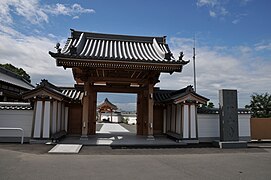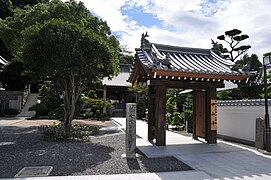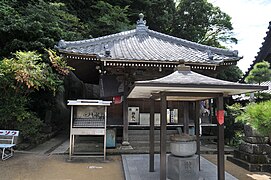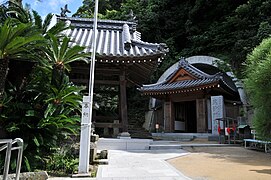Kōyama-ji
The Kōyama-ji ( Japanese 甲 山寺 ) with the Go Iōzan (医 王 山) and Tahōin (多 宝 院) is a temple of the Shingon direction of Buddhism in Zentsūji ( Kagawa Prefecture ). It lies at the foot of the 87 m high Kabutoyama (甲 山) and is bordered on the other side by a river. In the traditional count, it is the 74th temple on the Shikoku pilgrimage route .
history
The small temple is in the area where Priest Kukai spent his youth. He is said to have used part of the money that he received for regulating the Mannō Pond (満 濃 池), the largest reservoir in ancient times, for the construction of the temple. He is also said to have made the stone tablet with the image of St. Bishamon (毘 沙門 天).
investment
Once you have entered the temple through its gate (山門, Sammon; 1), a paved path continues until a simple, free-standing gate (1a) invites you to turn left. The paved path now leads to the main hall (本 堂, Hondō; 2), which is built from valuable Hinoki tribes . To the left, set back a little, is the hall in which the temple founder is venerated, the Daishidō (大師 堂, 3). Then you come to Bishamondō (毘 沙門 堂; 4), which is built 12 m into a rock cave.
photos
Remarks
- ↑ The symbol 甲 is reproduced here with its Japanese reading - Kabuto = helmet.
literature
- Kagawa-ken no rekishisampo henshu iinkai (Ed.): Kōyama-ji . In: Kagawa-ken no rekishi sampo. Yamakawa Shuppan, 2013. ISBN 978-4-634-24637-9 . Page 167.
Web links
Coordinates: 34 ° 13 ′ 59.5 " N , 133 ° 45 ′ 56.8" E
← Previous Temple: Shusshaka-ji | Kōyama-ji | Next temple: Zentsū-ji →





